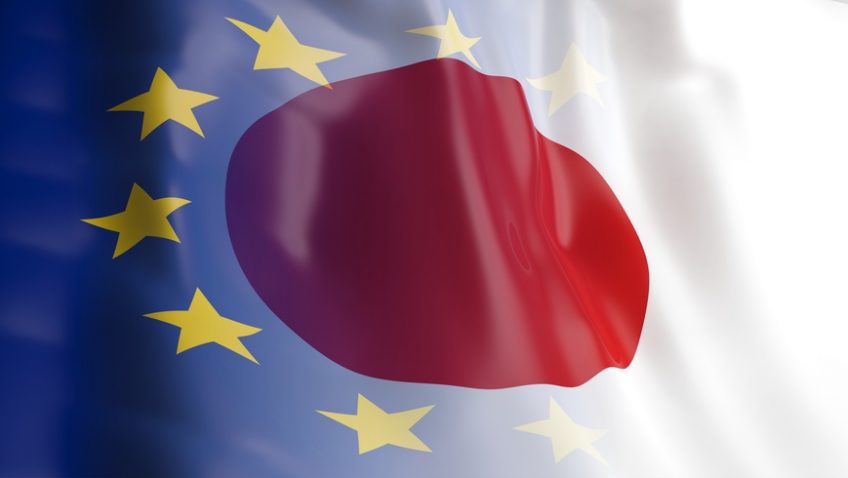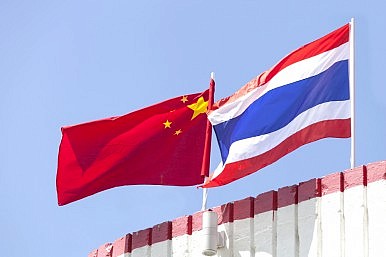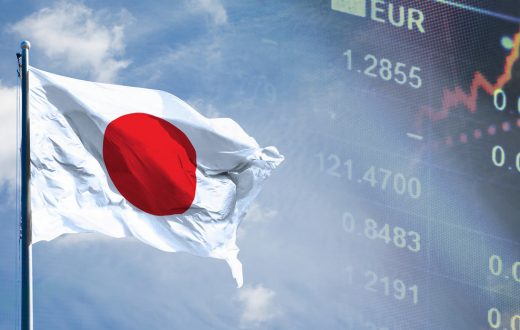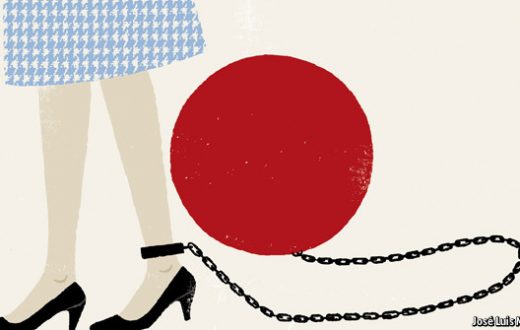Japan and the European Union (EU) have begun the new year with a triple success. In addition to the entry into force on February 1 of the world’s largest free trade agreement, the EU-Japan Economic Partnership Agreement (EPA), the past few weeks also brought the creation of “the world’s largest area of safe data flows” and the partial implementation of the EU-Japan Strategic Partnership Agreement (SPA). The three agreements, strategic, economic and digital, are at the heart of what is becoming possibly the most important bilateral relationship when it comes to protecting and promoting free trade, multilateralism, and the rules-based order.
The Economic Partnership Agreement
Less than a decade ago, both Japan and the European Union were seen as protectionist and the odds of them signing a comprehensive free trade agreement (FTA) seemed low. Yet, here we are, with Japan and the EU ratifying the world’s largest FTA, surpassing both the United States-Mexico-Canada Agreement and the Comprehensive and Progressive Agreement for Trans-Pacific Partnership (CPTPP) in terms of gross domestic product (GDP). The EU-Japan EPA doesn’t just connect two economies that are worth almost $25 trillion; it sets the standards for 21st century trade agreements.
Unlike a simple FTA, the agreement goes well beyond trade and tariffs, for example, by providing EU companies nondiscriminatory access as suppliers to the procurement markets of 54 cities in Japan. The EPA contains clauses pertaining to labor rights, environmental protection and climate change, state-owned enterprises, public procurement, market access, intellectual property, and data protection. According to the European Commission, the EPA is also the first free trade agreement that includes a specific reference to the Paris Agreement.
In 2017, the value of EU exports to Japan stood at 91 billion euros (60 billion euros in goods and 31 billion euros in services, for a total value of roughly $99 billion). On the other hand, the value of Japanese exports to the EU stood at 87 billion euros (69 billion euros in goods and 18 billion euros in services). The EU is thus Japan’s third largest trading partner.
Once fully implemented, over the next 15 years, the EPA will remove 97 percent of Japanese tariff lines on imported EU goods, which will save around 1 billion euros in paid duties. By then, 99 percent of European tariff lines on imported Japanese goods will also be eliminated, equivalent to around 2 billion euros in paid duties. It is estimated that thanks to these reductions, annual EU-Japan trade could increase by almost 36 billion euros, once the EPA is fully implemented.
The EPA’s biggest European winner is the agriculture sector, as Japan will remove duties on many cheeses (tariffs were as high as 29.8 percent) and wines (the average tariff stood at 15 percent), allow more imports of beef and pork, and ensure the protection of more than 200 European Geographical Indications such as: Roquefort, Parmigiano Reggiano, Feta cheese, Scottish Farmed Salmon, Lübecker Marzipan, Mortadella Bologna, Prosciutto di Parma, and numerous wines and spirits, like Champagne, Prosecco, Cotnari wine, Cognac, and Scotch Whisky.
Japan, on the other hand, will reap most rewards in the automotive industry. While EU customs duties on Japanese automobiles used to be 10 percent, they will be fully eliminated in eight years. More than 90 percentof European customs duties on car parts imported from Japan have already been eliminated.
For Japan, the EPA, which the government sees as “an important pillar of Abenomics’ growth strategy,” is the second great success in just two months. Last December, the CPTPP entered into force, as a testament to Japan’s transformation into a staunch promoter of free trade. It was Japan’s leadership that saved the CPTPPfrom demise after the United States withdrew from the Trans-Pacific Partnership in January 2017. With both the CPTPP and the EPA in force, Japanese companies and consumers stand to benefit from stronger trade links with markets worth more than a quarter of world GDP.
The EPA and the Strategic Partnership Agreement (SPA) were both envisioned in 2011, soon after the tragedy of the Great East Japan Earthquake. Negotiations for the EPA began in April 2013 and at first, moved rather slowly. But the pace picked up once the international environment started to change. The two sides reached an agreement in principle in July 2017, soon after the inauguration of U.S. President Donald Trump, in a clear signal that the EU and Japan remain committed to free trade. Negotiations for the EPA were finally concludedin December 2017 and the leaders of Japan and the EU signed the agreement in Tokyo last summer, subsequently proceeding with a speedy ratification.
One drawback of the EU-Japan EPA is tied to the reason it was possible for this agreement to be concluded so quickly and without any incidents. In 2016, when the EU was in the process of signing its agreement with Canada, the Comprehensive Economic and Trade Agreement (CETA), it had an unpleasant surprise, as the Walloon Region of Belgium opposed the agreement and threatened to block it. Later, in regard to the European Union-Singapore Free Trade Agreement, the Court of Justice of the European Union decided that its dispute settlement mechanism for investments fell within competences shared between the EU and member states, so the agreement needs to be jointly concluded by the EU and its member states. Considering that negotiations for an investment agreement were moving slower, while also taking into account these two previous events, the issue of investment protection was kept out of the EU-Japan EPA, so that the agreement’s entry into force cannot be delayed or prevented altogether by a single member state. Negotiations on investments continue, as the EU does not want to use the traditional Investor-State Dispute Settlement system, but instead create a permanent Investment Court System. The next meeting between EU and Japan negotiators is scheduled for March 2019.
The entry into force of the EPA alone would have been a notable achievement. But the EU and Japan are also celebrating a strategic and a digital agreement, which bolster the EPA.
The Data Movement Agreement
The EPA was connected to the formation of an EU-Japan area of safe data flows. On January 23, the European Commission adopted an adequacy decision on Japan, certifying the equivalency of its data protection norms, so that the personal data of European citizens can be freely moved to Japan. The Japanese government adopted an equivalent decision regarding the EU, bringing to life an idea for a 21st century agreement. Companies can now move data between the EU and Japan, creating new opportunities for the two digital markets.
Věra Jourová, the EU commissioner for justice, consumers and gender equality, highlighted the fact that “data is the fuel of global economy and this agreement will allow for data to travel safely between us to the benefit of both our citizens and our economies.” As the European Commission noted, through this agreement the two sides “affirm that, in the digital era, promoting high privacy and personal data protection standards and facilitating international trade must and can go hand in hand.”
As others have noted, this data agreement isn’t perfect, as recognition can be unilaterally withdrawn at any time. The ideal solution would have been to integrate the data agreement into the Economic Partnership Agreement. Nonetheless, it’s an important step forward in contrast with other FTAs that have been signed worldwide over the past years. In the 21st century, data has become one of the most important commodities and no discussion about free trade is really complete without addressing the free and safe flow of data between nations. The EU-Japan deal represents a model that can be replicated or improved by future agreements.
The Strategic Partnership Agreement
The final piece of the puzzle is the EU-Japan Strategic Partnership Agreement (SPA). While the SPA will enter into force only after all EU member states ratify or approve the agreement, parts of the agreement have been provisionally applied since February 1. The SPA is based on shared values and principles, such as democracy, the rule of law, and human rights. What makes the agreement special is the fact that it is legally binding, separating it from the sea of rhetorical “strategic partnerships” that the EU maintains with other important countries. The SPA establishes an EU-Japan Joint Committee that will coordinate the implementation of the partnership and resolve disputes.
Most importantly, the SPA opens a whole new era of EU-Japan global cooperation in numerous sectors, such as climate change and environmental protection, information society and cyber issues, outer space, development and economic policy, culture, science, technology and industrial cooperation, combating corruption, money laundering, illicit drugs, and terrorism, or the issue of weapons of mass destruction and conventional arms. Over the next few years, Brussels and Tokyo should make good use of each and every clause of this agreement to maximize its impact. The SPA also offers new opportunities for EU-Japan cooperation in the security realm, which could be an important geopolitical development.
The EU is in the process of intensifying military cooperation between member states and could even establish a European Army, while Japan, under Prime Minister Shinzo Abe, has announced the policy of “Proactive Contribution to Peace.” Thus the EU-Japan SPA is a perfect fit, enabling the two sides to identify new ways through which they can promote peace and security. The EU and Japan have already cooperated in counterpiracy activities near the Horn of Africa or in providing assistance in Niger and Mali. The SPA will enable the two powers to extend this cooperation at a time when the global security environment has become unstable.
A Bright Future for EU-Japan Cooperation
This trifecta of agreements greatly enhances EU-Japan relations, with global implications. While geography has placed them far apart, common values and principles have brought the EU and Japan close to each other, together defending these values.
In order to strengthen their ties in the long term, the EU and Japan should now look to intensify and diversify people-to-people ties, which are ultimately the basis of strong relations. EU-Japan people-to-people ties are, unfortunately, not as deep as current economic or political relations. The two sides should fund programs that enhance the quality and multiply the number of academic, educational, and cultural contacts and exchanges, which will bridge the cultural and linguistic gaps, bringing European and Japanese people closer. Academic and educational programs will also enable tighter scientific and research cooperation, whose achievements could ultimately boost the two economies.
In an era of disorder, growing protectionism, and reaction against globalization, the European Union and Japan have stood up as some of the strongest defenders of free trade and of a rules-based order. A decade ago, both the EPA and the SPA might have seemed far-fetched, yet they are now reality. The strengthening of EU-Japan relations is good news not just for their almost 600 million citizens, but also for the rest of the world, as a model of how international cooperation can overcome barriers and contribute to a better future.
This article is written by the excellent website The Diplomat, you can find it here https://thediplomat.com/2019/02/japan-and-europes-triple-partnership/








